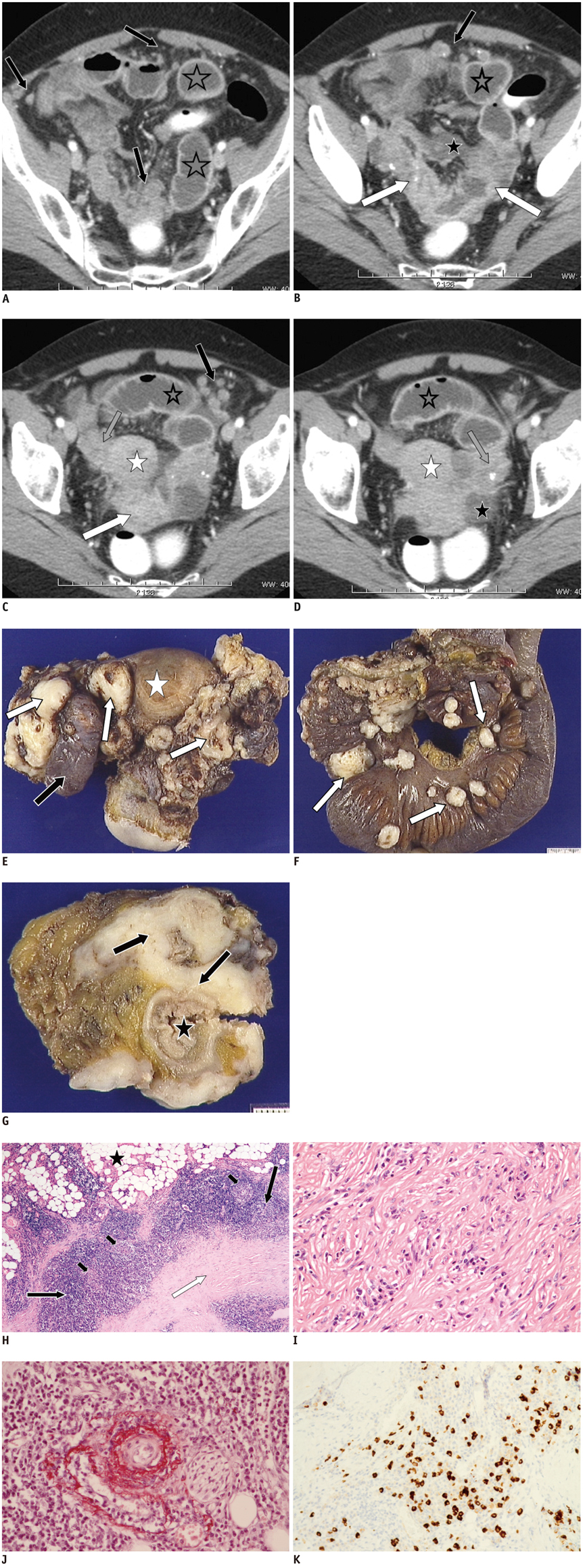Korean J Radiol.
2014 Feb;15(1):66-71. 10.3348/kjr.2014.15.1.66.
Small Bowel Obstruction Caused by Peritoneal Immunoglobulin G4-Related Disease Mimicking Carcinomatosis: Case Report
- Affiliations
-
- 1Department of Diagnostic Radiology, Clinique St. Luc, Bouge, Namur 5004, Belgium. bcoulier@skynet.be
- 2Department of Internal Medicine, Clinique St. Luc, Bouge, Namur 5004, Belgium.
- 3Institute of Pathology and Genetics, Gosselies 6-6041, Belgium.
- 4Department of Visceral Surgery, Clinique St. Luc, Bouge, Namur 5004, Belgium.
- KMID: 1711479
- DOI: http://doi.org/10.3348/kjr.2014.15.1.66
Abstract
- We hereby report a case of diffuse pelvic peritoneal involvement by immunoglobulin G4-related disease (IgG4-RD). Numerous pelvic masses and nodules showing delayed enhancement on enhanced abdominal CT were found to congregate in the pelvic organs of a 57-year-old female presenting with intestinal subocclusion. The differentiation between peritoneal IgG4-RD and pelvic peritoneal carcinomatosis was only made by histopathology and immunohistochemistry performed after surgical resection. Autoimmune pancreatitis represents the historical prototype of IgG4-RD, but the spectrum of manifestations involving various organs has expanded during the last decade. In this report, we shortly review this clinical entity.
MeSH Terms
Figure
Reference
-
1. Divatia M, Kim SA, Ro JY. IgG4-related sclerosing disease, an emerging entity: a review of a multi-system disease. Yonsei Med J. 2012; 53:15–34.2. Ryu JH, Horie R, Sekiguchi H, Peikert T, Yi ES. Spectrum of Disorders Associated with Elevated Serum IgG4 Levels Encountered in Clinical Practice. Int J Rheumatol. 2012; 2012:232960.3. Hamano H, Kawa S, Horiuchi A, Unno H, Furuya N, Akamatsu T, et al. High serum IgG4 concentrations in patients with sclerosing pancreatitis. N Engl J Med. 2001; 344:732–738.4. Kim JH, Byun JH, Lee SS, Kim HJ, Lee MG. Atypical manifestations of IgG4-related sclerosing disease in the abdomen: imaging findings and pathologic correlations. AJR Am J Roentgenol. 2013; 200:102–112.5. Kamisawa T, Funata N, Hayashi Y, Eishi Y, Koike M, Tsuruta K, et al. A new clinicopathological entity of IgG4-related autoimmune disease. J Gastroenterol. 2003; 38:982–984.6. Vlachou PA, Khalili K, Jang HJ, Fischer S, Hirschfield GM, Kim TK. IgG4-related sclerosing disease: autoimmune pancreatitis and extrapancreatic manifestations. Radiographics. 2011; 31:1379–1402.7. Moh IH, Kim JB, Shin SR, Jung SW, Park SH, Kim JW, et al. A case of intraperitoneal immunoglobulin G4-related inflammatory pseudotumor. Korean J Gastroenterol. 2012; 60:258–261.8. Umehara H, Okazaki K, Masaki Y, Kawano M, Yamamoto M, Saeki T, et al. A novel clinical entity, IgG4-related disease (IgG4RD): general concept and details. Mod Rheumatol. 2012; 22:1–14.9. Stone JH, Khosroshahi A, Deshpande V, Chan JK, Heathcote JG, Aalberse R, et al. Recommendations for the nomenclature of IgG4-related disease and its individual organ system manifestations. Arthritis Rheum. 2012; 64:3061–3067.10. Yamashita H, Takahashi Y, Ishiura H, Kano T, Kaneko H, Mimori A. Hypertrophic pachymeningitis and tracheobronchial stenosis in IgG4-related disease: case presentation and literature review. Intern Med. 2012; 51:935–941.11. Inoue D, Zen Y, Abo H, Gabata T, Demachi H, Yoshikawa J, et al. Immunoglobulin G4-related periaortitis and periarteritis: CT findings in 17 patients. Radiology. 2011; 261:625–633.12. Choi JW, Kim SY, Moon KC, Cho JY, Kim SH. Immunoglobulin G4-related sclerosing disease involving the urethra: case report. Korean J Radiol. 2012; 13:803–807.13. Chen TS, Montgomery EA. Are tumefactive lesions classified as sclerosing mesenteritis a subset of IgG4-related sclerosing disorders? J Clin Pathol. 2008; 61:1093–1097.14. Minato H, Shimizu J, Arano Y, Saito K, Masunaga T, Sakashita T, et al. IgG4-related sclerosing mesenteritis: a rare mesenteric disease of unknown etiology. Pathol Int. 2012; 62:281–286.
- Full Text Links
- Actions
-
Cited
- CITED
-
- Close
- Share
- Similar articles
-
- Immunoglobulin G4-Related Lung Disease Mimicking Lung Cancer: Two Case Reports
- Erdheim–Chester Disease Involving the Biliary System and Mimicking Immunoglobulin G4-Related Disease: A Case Report
- A Case of Recurrent Ischemic Stroke Associated with Immunoglobulin G4-Related Disease
- A Case of Immunoglobulin G4-Related Sclerosing Disease Mimicking Lung Cancer
- A Case of Small Bowel Obstruction due to Peritoneal Encapsulation


